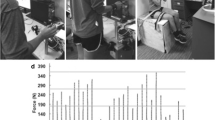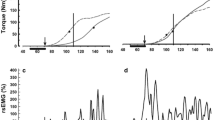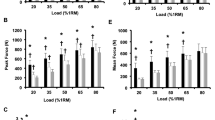Abstract
The aging process causes many changes in muscle strength, and analysis of explosive force from handgrip strength seems to be useful and promising in studying the aging musculoskeletal system. Therefore, the purpose of this study was to investigate if explosive force parameters [rate of force development (RFD) and contractile impulse (CI) over the time interval of 0–200 ms from the onset of contraction] during handgrip efforts decline differently than maximum handgrip strength with increasing age. Twenty healthy young women (20–27 years) and 65 healthy elderly women, assigned into three age groups (50–64, 65–74, and 75–86 years), participated in this study. All participants performed two maximal grip attempts. Handgrip data were recorded as force–time curves, peak force, and explosive force parameters. Our results revealed that peak force decreased significantly (p < 0.05) for those who are 65 years old, while explosive force parameters decreased significantly (p < 0.05) for those aged 50 years. These data indicate that the decline in explosive grip force-generating capacity may begin earlier (i.e., for those aged 50 years old) than peak force during the aging process. Our findings suggest that the aging process reduces the explosive grip force-generating capacity before affecting peak force.



Similar content being viewed by others
References
Aagaard P, Simonsen EB, Andersen JL, Magnusson P, Dyhre-Poulsen P (2002) Increased rate of force development and neural drive of human skeletal muscle following resistance training. J Appl Physiol 93:1318–1326
Bean JF, Kiely DK, Herman S, Leveille SG, Mizer K, Frontera WR, Fielding RA (2002) The relationship between leg power and physical performance in mobility-limited older people. J Am Geriatr Soc 50:461–467
Clarkson PM, Kroll W, Melchionda AM (1981) Age, isometric strength, rate of tension development and fiber type composition. J Gerontol 36:648–653
Cruz-Jentoft AJ, Baeyens JP, Bauer JM, Boirie Y, Cederholm T, Landi F, Martin FC, Michel JP, Rolland Y, Schneider SM, Topinková E, Vandewoude M, Zamboni M (2010) Sarcopenia: European consensus on definition and diagnosis: report of the European Working Group on sarcopenia in older people. Age Ageing 39:412–423
Doherty TJ (2003) Invited review: aging and sarcopenia. J Appl Physiol 95:1717–1727
Frontera WR, Hughes VA, Lutz KJ, Evans WJ (1991) A cross-sectional study of muscle strength and mass in 45- to 78-yr-old men and women. J Appl Physiol 71:644–650
Goodpaster BH, Park SW, Harris TB, Kritchevsky SB, Nevitt M, Schwartz AV, Simonsick EM, Tylavsky FA, Visser M, Newmanet AB (2006) The loss of skeletal muscle strength, mass, and quality in older adults: the health, aging and body composition study. J Gerontol A Biol Sci Med Sci 61:1059–1064
Grimby G, Saltin B (1983) The ageing muscle. Clin Physiol 3:209–218
Harridge SDR (1996) The muscle contractile system and its adaptation to training. Med Sport Sci 41:82–94
Hughes VA, Frontera WR, Wood M, Evans WJ, Dallal GE, Roubenoff R, Singh MAF (2001) Longitudinal muscle strength changes in older adults: influence of muscle mass, physical activity, and health. J Gerontol A Biol Sci Med Sci 56:209–217
Janssen I, Heymsfield SB, Ross R (2002) Low relative skeletal muscle mass (sarcopenia) in older persons is associated with functional impairment and physical disability. J Am Geriatr Soc 50:889–896
Klass M, Baudry S, Duchateau J (2008) Age-related decline in rate of torque development is accompanied by lower maximal motor unit discharge frequency during fast contractions. J Appl Physiol 104:739–746
Lauretani F, Russo CR, Bandinelli S, Bartali B, Cavazzini C, Di Iorio A, Corsi AM, Rantanen T, Guralnik JM, Ferrucci L (2003) Age-associated changes in skeletal muscles and their effect on mobility: an operational diagnosis of sarcopenia. J Appl Physiol 95:1851–1860
Lee WS, Cheung WH, Qin L, Tang N, Leung KS (2006) Age-associated decrease of type IIA/B human skeletal muscle fibers. Clin Orthop Relat Res 450:231–237
Metter EJ, Talbot LA, Schrager M, Conwit RA (2004) Arm-cranking muscle power and arm isometric muscle strength are independent predictors of all-cause mortality in men. J Appl Physiol 96:814–821
Nair KS (2005) Aging muscle. Am J Clin Nutr 81:953–963
Paasuke M, Ereline J, Gapeyeva H, Sirkel S, Sander P (2000) Age-related differences in twitch contractile properties of plantarflexor muscles in women. Acta Physiol Scand 170:51–7
Pereira MP, Gonçalves M (2011) Muscular coactivation (CA) around the knee reduces power production in elderly women. Arch Gerontol Geriatr 52:317–321
Pereira LS, Narciso FM, Oliveira DM, Coelho FM, Souza DG, Dias RC (2009) Correlation between manual muscle strength and interleukin-6 (IL-6) plasma levels in elderly community-dwelling women. Arch Gerontol Geriatr 48:313–316
Pereira R, Cardoso BS, Itaborahy AS, Machado M (2011) Analysis of handgrip strength from elderly women: a comparative study among age groups. Acta Med Port 24(4):521–526
Rantanen T, Masaki K, Foley D, Izmirlian G, White L, Guralnik JM (1998) Grip strength changes over 27 yr in Japanese-American men. J Appl Physiol 85:2047–2053
Rantanen T, Guralnik JM, Foley D, Masaki K, Leveille S, Curb JD, White L (1999) Midlife hand grip strength as a predictor of old age disability. JAMA 281:558–560
Skelton DA, Kennedy J, Rutherford OM (2002) Explosive power and asymmetry in leg muscle function in frequent fallers and non-fallers aged over 65. Age Ageing 31:119–125
Vandervoort AA, McComas AJ (1986) Contractile changes in opposing muscles of the human ankle joint with aging. J Appl Physiol 61:361–367
Watanabe K, Tsubota S, Chin G, Aoki M (2011) Differences in parameters of the explosive grip force test between young and older women. J Gerontol A Biol Sci Med Sci 66A:554–558
Conflict of interest
No potential conflicts of interest were disclosed.
Author information
Authors and Affiliations
Corresponding author
About this article
Cite this article
Schettino, L., Luz, C.P.N., de Oliveira, L.E.G. et al. Comparison of explosive force between young and elderly women: evidence of an earlier decline from explosive force. AGE 36, 893–898 (2014). https://doi.org/10.1007/s11357-013-9612-1
Received:
Accepted:
Published:
Issue Date:
DOI: https://doi.org/10.1007/s11357-013-9612-1




